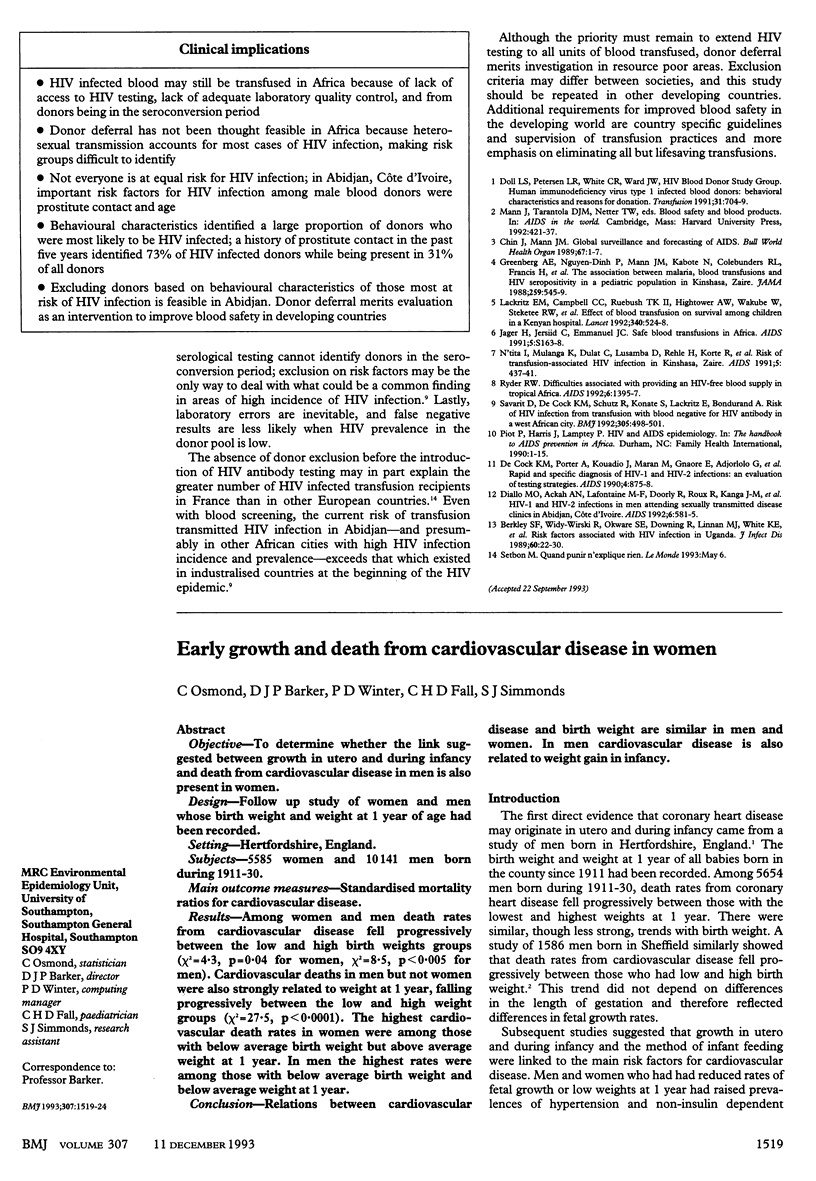Abstract
OBJECTIVE--To examine the potential impact of deferral of blood donors at high risk of HIV infection in a west African city where blood is screened for HIV antibodies but no other special measures are taken to protect the blood supply. DESIGN--Cross sectional study. SETTING--National Blood Transfusion Centre and Project RETRO-CI, an international collaborative AIDS research project, Abidjan, Côte d'Ivoire. SUBJECTS--1257 male first time blood donors. INTERVENTIONS--Blood donors were interviewed about demographic and behavioural characteristics and tested for HIV antibodies by enzyme immunoassay and, if positive, synthetic peptide based tests. MAIN OUTCOME MEASURES--HIV antibody status in relation to presence of behavioural risk factors; calculation of sensitivity, specificity, and predictive values of specific criteria for excluding HIV infected donors. RESULTS--The overall prevalence of HIV infection was 11.4%. The most important risk factors for HIV positivity were prostitute contact and being aged 30-39 years. For identifying seropositive donors individual criteria had sensitivity, specificity, and positive predictive values ranging from 15% to 98%, 38% to 91%, and 17% to 30% respectively. Prostitute contact in the past five years would have excluded 31% of all donors and 73% of HIV infected donors. 27% of those excluded would have been HIV positive. CONCLUSIONS--The widespread assumption that donor deferral is not feasible in sub-Saharan Africa needs reassessment. In Abidjan this approach was well accepted and potentially effective. Donor deferral requires evaluation as a strategy for improving blood safety in resource poor areas with high rates of HIV infection.
Full text
PDF


Selected References
These references are in PubMed. This may not be the complete list of references from this article.
- Berkley S. F., Widy-Wirski R., Okware S. I., Downing R., Linnan M. J., White K. E., Sempala S. Risk factors associated with HIV infection in Uganda. J Infect Dis. 1989 Jul;160(1):22–30. doi: 10.1093/infdis/160.1.22. [DOI] [PubMed] [Google Scholar]
- Chin J., Mann J. Global surveillance and forecasting of AIDS. Bull World Health Organ. 1989;67(1):1–7. [PMC free article] [PubMed] [Google Scholar]
- De Cock K. M., Porter A., Kouadio J., Maran M., Gnaore E., Adjorlolo G., Lafontaine M. F., Bretton G., Damet G. M., Odehouri K. Rapid and specific diagnosis of HIV-1 and HIV-2 infections: an evaluation of testing strategies. AIDS. 1990 Sep;4(9):875–878. doi: 10.1097/00002030-199009000-00007. [DOI] [PubMed] [Google Scholar]
- Diallo M. O., Ackah A. N., Lafontaine M. F., Doorly R., Roux R., Kanga J. M., Heroin P., De Cock K. M. HIV-1 and HIV-2 infections in men attending sexually transmitted disease clinics in Abidjan, Côte d'Ivoire. AIDS. 1992 Jun;6(6):581–585. doi: 10.1097/00002030-199206000-00010. [DOI] [PubMed] [Google Scholar]
- Doll L. S., Petersen L. R., White C. R., Ward J. W. Human immunodeficiency virus type 1-infected blood donors: behavioral characteristics and reasons for donation. The HIV Blood Donor Study Group. Transfusion. 1991 Oct;31(8):704–709. doi: 10.1046/j.1537-2995.1991.31892023494.x. [DOI] [PubMed] [Google Scholar]
- Greenberg A. E., Nguyen-Dinh P., Mann J. M., Kabote N., Colebunders R. L., Francis H., Quinn T. C., Baudoux P., Lyamba B., Davachi F. The association between malaria, blood transfusions, and HIV seropositivity in a pediatric population in Kinshasa, Zaire. JAMA. 1988 Jan 22;259(4):545–549. [PubMed] [Google Scholar]
- Jäger H., Jersild C., Emmanuel J. C. Safe blood transfusions in Africa. AIDS. 1991;5 (Suppl 1):S163–S168. [PubMed] [Google Scholar]
- Lackritz E. M., Campbell C. C., Ruebush T. K., 2nd, Hightower A. W., Wakube W., Steketee R. W., Were J. B. Effect of blood transfusion on survival among children in a Kenyan hospital. Lancet. 1992 Aug 29;340(8818):524–528. doi: 10.1016/0140-6736(92)91719-o. [DOI] [PubMed] [Google Scholar]
- N'tita I., Mulanga K., Dulat C., Lusamba D., Rehle T., Korte R., Jäger H. Risk of transfusion-associated HIV transmission in Kinshasa, Zaire. AIDS. 1991 Apr;5(4):437–439. doi: 10.1097/00002030-199104000-00013. [DOI] [PubMed] [Google Scholar]
- Ryder R. W. Difficulties associated with providing an HIV-free blood supply in tropical Africa. AIDS. 1992 Nov;6(11):1395–1397. doi: 10.1097/00002030-199211000-00026. [DOI] [PubMed] [Google Scholar]
- Savarit D., De Cock K. M., Schutz R., Konate S., Lackritz E., Bondurand A. Risk of HIV infection from transfusion with blood negative for HIV antibody in a west African city. BMJ. 1992 Aug 29;305(6852):498–502. doi: 10.1136/bmj.305.6852.498. [DOI] [PMC free article] [PubMed] [Google Scholar]


